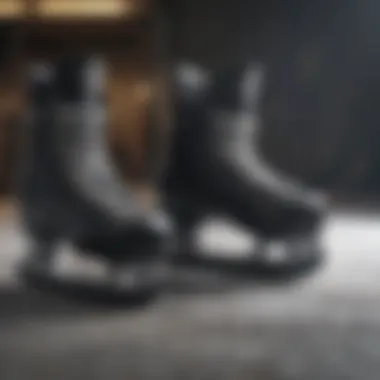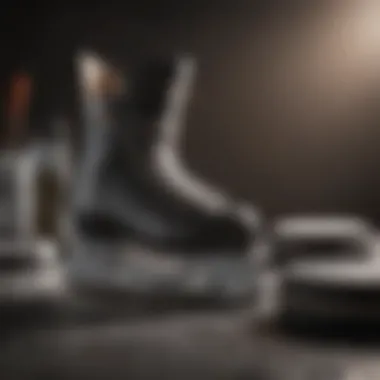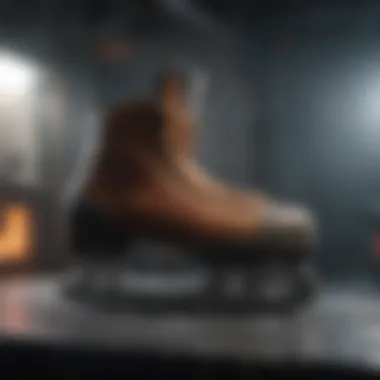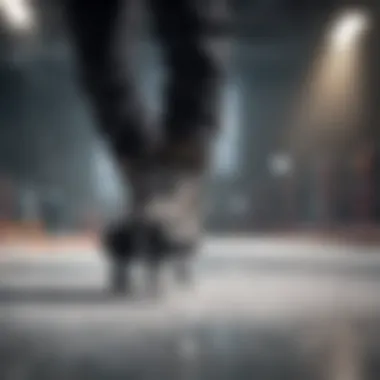Expert Guide to Baking Hockey Skates at Home


Intro
Baking hockey skates at home is an essential practice that can enhance not only fit but also overall comfort for players. Whether you are a newcomer to the sport or have years of experience, understanding the nuances of this process can significantly impact your on-ice performance. This guide will provide a detailed breakdown of the methods, tools, and precautions necessary for successfully baking your skates.
Baking involves applying heat to the boots, allowing them to soften and mold to the unique shape of your feet. This custom fit helps in maximizing both comfort and control while skating. Many players choose to bake their skates at home to avoid the extra trip to a pro shop and to personalize the process according to their own preferences.
In the following sections, we will cover the vital aspects of baking hockey skates, including required tools, step-by-step instructions, safety measures, and maintenance tips. Also, we will explore the importance of properly adjusting your skates to match your foot shape and skating style.
Understanding how to bake skates can lead to a transformative skating experience. With this knowledge, player’s can elevate their confidence and agility on the ice.
Extreme Sport Overview
Prolusion to Hockey
Hockey is a fast-paced and physically demanding sport enjoyed by players globally. It has its origins predating the 19th century, but it evolved into the organized team sport we recognize today, with formal rules established in the mid-1800s. Players compete on ice, aiming to score goals by propelling a puck into the opposing team’s net.
Brief History of Hockey
Hockey's roots are linked closely with various stick-and-ball games played throughout history. The modern game, officially established in Canada, gained popularity in the United States and Europe as well. Since the inception of the National Hockey League (NHL) in 1917, hockey has become one of the most watched sports in North America.
Equipment Required
To play hockey, several essential equipment items are necessary:
- Hockey skates
- Stick
- Helmet
- Shoulder pads
- Elbow pads
- Shin guards
- Gloves
These items are vital for protection and performance on the ice. Each component plays a crucial role in ensuring safety and enhancing the player's ability to engage effectively in the sport.
Safety Tips and Guidelines
Safety is paramount in hockey, due to its physical nature. It is crucial to understand proper body positioning and maintain focus during gameplay. Equipment must be properly fitted and in good repair to prevent injuries. Wearing mouthguards and face shields can further decrease the chance of dental or facial injuries.
Relevant Statistics and Facts
According to research, hockey ranks among the top ten most popular sports in terms of participation worldwide. More than 2 million youth players are active in North America. The increasing popularity emphasizes the importance of safe and proficient play. As more individuals embrace hockey, understanding best practices regarding gear maintenance, including skates, becomes even more significant.
Quote: Properly fitted skates enhance not only comfort but also performance on the ice. They are an integral part of the player’s gear.
End
In the end, understanding and engaging with the techniques and tools necessary for baking skates can lead to a more fulfilling hockey experience. The players who are dedicated to perfecting their equipment will find an edge in their performance. By following this guide, players prepare themselves for successful skating sessions tailored specifically to their unique needs.
Preface to Baking Hockey Skates
Baking hockey skates is a critical process that greatly influences the comfort and fit of the skates. For both novice and experienced players, properly baking skates can afford a customized level of support that enhances performance on the ice. The significance of this technique lies in its capacity to mold the skates to the player's unique foot shape and skating style. This article delves into the essential aspects of baking skates, aiming to equip athletes with the knowledge required to undertake this task at home.
Understanding the Concept of Baking Skates
Baking skates involves applying heat to the boot materials to soften them, which allows for a more precise fit when the skates cool down around the foot. The primary goal here is to minimize the break-in period, which can often be uncomfortable and lead to blisters or pain. When skates are baked, the materials adapt better to the contours of the foot. This adaptation results in skates that are more aligned with the player's foot, offering better stability and control.
It is essential to note that not all skates are suitable for baking. Generally, high-quality skates designed for this purpose typically consist of certain plastics or composites that respond well to heat. A player must also consider the manufacturer's guidelines to ensure the correct baking procedure is applied. Misapplication of heat can result in damage and mitigate the benefits of the process.
Why Baking is Beneficial for Hockey Players
Baking hockey skates holds multiple benefits that directly enhance a player's overall experience on the ice. First and foremost, it contributes to a custom fit. Skates that fit properly reduce movement within the boot, resulting in improved power transfer during skating.
Another notable benefit is the reduction in discomfort caused by tight or ill-fitting skates. Many players experience pain or numbness when using new skates because the materials have not yet adapted to their foot shape. After a proper baking session, the skates should feel significantly more comfortable and eliminate many of these issues.


Additionally, baked skates can improve performance. With a well-fitted skateboard, a player can achieve increased speed, better agility, and enhanced overall responsiveness.
Properly baking your skates can transform your skating experience, making it more enjoyable and effective on the ice.
In summary, baking hockey skates is not merely a suggestion for serious players; it is an essential practice that ensures skates are tailored to the individual. This personalization can have a profound impact on performance, comfort, and even injury prevention.
Necessary Tools and Equipment
The process of baking hockey skates requires careful planning and the right tools. Having appropriate equipment ensures not only efficiency but also safety. Understanding the necessary tools is vital to achieving the best results for your skates. Failure to use proper equipment may lead to inferior fit or even damage your skates.
Skate Oven or Alternative Heating Source
A skate oven is the preferred choice for baking hockey skates. It provides a controlled and consistent temperature, which is crucial for effectively softening the materials of the skates. If you lack a dedicated skate oven, there are alternatives, such as conventional ovens or heat guns. However, these must be used with caution. When using home ovens, ensure the temperature settings align precisely with manufacturer recommendations for your specific skate model.
When opting for a heat gun, you must control the distance from the skates to avoid overheating them. With any of these options, check that you only target the areas needing adjustment without compromising the structure. The purpose remains the same: ensure that materials become malleable enough for a proper fit.
Thermometer for Temperature Monitoring
Monitoring temperature is essential during the baking process. A thermometer helps maintain the appropriate heat level, minimizing the risk of damaging the skates. Different materials have varying melting points; thus, knowing the exact temperature can prevent unwanted consequences.
A digital or infrared thermometer can be an excellent choice for ease of use and accuracy. Ensure that you test the temperature of the oven or heating source before placing the skates inside. Consistency in monitoring allows for a uniform heat distribution throughout the skates, leading to an optimal fit.
Protective Gear and Accessories
Safety is paramount when baking hockey skates, and wearing protective gear is a crucial component. Heat-resistant gloves should always be used to protect your hands from burns during the handling of hot equipment. These gloves can ensure grip and dexterity while also providing a safeguard against potential heat exposure.
Moreover, it is wise to equip yourself with eyewear protection. While working with heat sources, small particles from the skates or sudden heat spikes can be a concern. Use safety glasses to shield your eyes. Having a mat or dedicated working space can also prevent slippage or accidental falls when navigating through the setup. Prioritizing safety ensures that the baking process remains smooth and secure.
Preparation Steps
Preparation Steps are a vital part of the baking process for hockey skates. Taking time to prepare ensures that the skates mold accurately to the unique shape of your feet, promoting comfort and enhancing performance. Neglecting this stage may lead to discomfort or improperly fitting skates, which can affect your skating ability significantly. Furthermore, a well-thought-out preparation makes the subsequent baking steps more efficient and effective.
Inspecting the Skates for Damage
Before starting the baking procedure, it is essential to inspect the skates for any signs of damage. Look for cracks, tears, or unusual bending in the materials. Check the stitching as well, ensuring it is intact. Small damages can impact the skate's effectiveness and undermine the entire baking process. If you find any issues, it might be worthwhile to repair them first or even consider replacement for a better skating experience. Skates are an investment, and ensuring their integrity is paramount to achieving optimal performance.
Removing Insoles and Laces
The next step is to remove the insoles and laces from the skates. This action is critical for a proper fit and even baking. Insoles can trap heat and moisture, leading to uneven heating, which could affect how well the skates conform to your feet. Laces, if left on, might get damaged in the oven's heat, so it is best to take them off as a precaution. By addressing these elements ahead of time, you establish a clean slate for successfully baking your skates.
Preheating the Oven
Preheating the oven is the final step in preparation. An accurate temperature ensures the skates bake uniformly. It is typically recommended to set the oven to 175°F (80°C) for most hockey skates. Utilizing a thermometer to monitor the temperature is recommended to avoid overheating. If the skates are exposed to excessive heat, they may warp or become unusable. Take care when placing them in the oven; ensure they lay flat and that no part is at risk of being overcooked.
Tip: Always read the manufacturer's guidelines regarding the optimal baking temperature and time for your specific skates. This information can be vital to achieving the best possible fit.
Preparation Steps, though often overlooked, lay the groundwork for a successful experience. Taking the time to properly inspect, dismantle, and preheat not only safeguards the skates but also enhances the quality of your skating performance.
Baking Process
Baking hockey skates is a crucial step in customizing how they feel and perform on the ice. When skates are heated, the material becomes more pliable, enabling them to conform to the unique shape of an individual’s foot. This process not only enhances comfort but also boosts overall performance. Properly baked skates can provide better energy transfer and responsiveness, which are essential for an athlete’s on-ice effectiveness.
Placing the Skates in the Oven
Once the oven is preheated, the next crucial step is carefully placing the skates inside. Here are essential considerations:
- Ensure the skates are clean and free of debris before insertion.
- Position the skates upright to maximize airflow, aiding even heating.
- Avoid overlapping skates or crowding the oven to promote uniform baking temperatures.
It is advisable not to exceed the recommended time in the oven to prevent damaging the boot materials. Most skates require about 8 to 12 minutes of heating. Observing this time frame is vital for achieving the best shape without compromising the structural integrity of the skates.


Monitoring the Time and Temperature
Monitoring both time and temperature is essential during the baking process. An accurate thermometer, such as an infrared thermometer, can provide insights into the oven’s internal temperature. The ideal temperature range for baking skates is generally between 180°F to 200°F. Maintaining this range ensures the material softens effectively without becoming overly compromised.
- Set a timer to avoid losing count of how long the skates have been in the oven.
- Check periodically to ensure everything is proceeding as planned.
It is imperative to resist the urge to open the oven too frequently, as this can lead to temperature fluctuations.
Finalizing the Baking Session
After the baking time has elapsed, the skates need careful handling. Using protective gloves, gently remove the skates from the oven. They will be hot, so caution is necessary. Once removed, allow skates to cool slightly before placing them on your feet. This cooling period helps the materials settle into their new shapes.
- Fasten the skates while they are warm for the best fit.
- Walk around for a little while to help mold the boot as it cools to your foot shape.
Finalizing the baking session properly can significantly enhance how the skates fit and feel during use.
Fitting Your Skates
Fitting your skates properly is essential for any athlete serious about performing at their best on the ice. A well-fitted skate offers crucial support and enhances overall comfort, which can significantly impact performance during games or practice. When skates fit correctly, athletes can enjoy improved balance and control, allowing for more precise skating maneuvers. Conversely, improper fit may lead to discomfort or even injuries, detracting from the player's experience.
How to Properly Put on the Skates
To ensure a proper fit, learn the correct way to put on your skates. Begin by loosening the laces and carefully sliding your foot into the boot. Make sure your heel is firmly in place; you should feel your heel touching the back of the skate. This step is crucial because it ensures that your foot is securely positioned within the boot. Once your foot is inside, gradually tighten the laces, starting from the bottom and moving to the top.
Pay attention to the fit around the ankle and the forefoot. The goal is to achieve a snug feeling without pinching. If you feel too much pressure or your foot feels cramped, consider adjusting the tightness or trying a different pair of socks to improve comfort. Remember to tighten the laces until your foot feels securely locked in, but not painfully so.
Lacing Techniques for Optimal Fit
Lacing is an often overlooked aspect of achieving an optimal skate fit. The way you lace your skates can influence how your foot sits in the boot and impacts ankle support. Here are a few techniques:
- Criss-Cross Lacing: This is the most common technique. It provides a balanced fit and allows for even pressure distribution across the foot.
- Skip Lacing: For those who experience discomfort over specific spots, skipping a lace hole can alleviate pressure and create a more comfortable fit.
- Locking Laces: This method involves pulling the lace tight and using a final loop to lock in tension, which can enhance ankle support.
When lacing your skates, ensure that each section of the laces is tightened appropriately. Start from the toe and make your way up, consistently checking for a snug fit. The proper lacing technique not only aids in comfort but also contributes to greater stability and control on the ice.
Proper fitting and lacing can dramatically affect the skating experience. Don’t underestimate its importance.
Post-Baking Care
Post-baking care is a critical step in the process of preparing hockey skates for optimal performance. After baking, the skate materials take on a shape that is more contoured to the player’s foot. However, improper care can lead to issues that negate the benefits of baking. Taking time to properly dry and clean the skates can enhance durability and maintain the personalized fit achieved through baking.
Suggestions for Drying Skates
After the baking process, it is essential to allow skates to dry properly to maintain their shape and performance. Here are some suggested methods for drying:
- Air Drying: Place the skates in a well-ventilated area away from direct sunlight. This method is gentle and ensures the integrity of the materials.
- Remove Liners: Take out the liners if possible. This allows both the outer shell and the inner components to dry effectively.
- Avoid Direct Heat: Never use heaters or hairdryers, as excessive heat can warp the structure of the skate.
Proper drying enhances the likelihood that the shape holds, which is vital for achieving the most comfortable fit.
Cleaning and Maintenance Tips
Maintaining hockey skates after baking is vital to prolonging their life. Here are some best practices:
- Regular Cleaning: After each use, wipe down the exterior with a damp cloth to remove ice, dirt, and debris. This practice helps prevent rusting and deterioration.
- Inspections: Frequently check for any damage or wear. Pay close attention to the blade holders and the blades, as these are crucial for performance.
- Lubricating Parts: Applying a small amount of specialized lubricant to moving parts can help maintain functionality and prevent sticking.
- Storage Considerations: Store skates in a cool, dry place, ideally in a skate bag. Avoid leaving them in a hot or humid environment to maintain structural integrity.
Properly caring for your skates not only extends their lifespan but also ensures the fit remains snug and comfortable.
By following these guidelines for post-baking care, players can ensure that their hockey skates continue to perform at their best, delivering comfort and precision on the ice.
Common Issues and Troubleshooting


Understanding and addressing common issues that arise during the baking process is crucial for hockey players. Even with careful preparation, problems can occur that may affect the fit and comfort of the skates. This section aims to provide insightful details on how to effectively identify discomfort and resolve any baking-related issues. Knowing how to troubleshoot these problems will not only enhance your performance but also prolong the lifespan of your equipment.
Identifying Misfits and Discomfort
Recognizing discomfort in skate fit is the first step toward achieving optimal performance. Misfits can manifest in various ways including tightness, pressure points, or excess movement during use.
Here are some telltale signs that your skates might not fit properly:
- Numbness or pinching: This could indicate that the boot is too tight in certain areas.
- Excessive heel lift: If your heel lifts significantly while skating, it may mean the skate is too loose.
- Blisters or hot spots: Frequent irritation can suggest wrong fit or misalignment of the skate.
To accurately pinpoint misalignment, try gently flexing your ankles while wearing the skates. If you experience any of the issues mentioned above, it's essential to re-evaluate the baking process or consider a different size or model.
Resolving Problems in the Baking Process
Troubleshooting the baking process effectively can prevent discomfort and enhance the fit of your skates. Common problems could stem from incorrect oven temperatures, improper timing, or not preparing the skates adequately.
To address these issues, follow these steps:
- Check oven temperature: Ensure your skate oven reaches the recommended temperature, which is typically around 175°F to 180°F (about 80°C to 82°C). Using a thermometer to verify this can avoid problems due to overheating.
- Adjust baking time: It’s important not to exceed the recommended baking duration as this can adversely affect the materials. Generally, 8-10 minutes should suffice but always follow the manufacturer's guidelines.
- Inspect skates post-baking: After you bake your skates, look for any signs of deformation or damage. If you notice warped areas, they may require additional attention or another baking session.
- Seek professional advice: If you're struggling to resolve these issues, don’t hesitate to reach out to professionals or fellow athletes for insights.
By understanding these common problems and employing effective solutions, players can ensure their equipment performs at its best, ultimately supporting their athletic endeavors.
"Proper fitting skates are vital for performance and injury prevention. Misfits can lead to discomfort on and off the ice."
Closure
Baking hockey skates at home is not merely a process; it is a pivotal element in ensuring that players achieve the comfort and customized fit necessary for optimal performance on the ice. Understanding the tales of each step in the baking process can make a significant difference in how skates feel and respond during gameplay. From the preheating of the skate oven to the final adjustments after baking, it’s crucial to approach the task with care.
Recap of the Baking Process
To encapsulate, the baking process involves several key stages:
- Preparation: Inspect the skates, remove insoles and laces, and preheat the oven to the desired temperature.
- Baking: Safely place the skates into the oven, monitoring both time and temperature carefully.
- Cooling and Fitting: After baking, ensure the skates cool appropriately before putting them on, allowing them to mold accurately to the foot.
The importance of each phase cannot be overstated. Deviating from the recommended guidelines may result in a less-than-ideal fit, drawing attention to potential pain points during play.
Encouragement for Personalized Fit
Finally, the emphasis on achieving a personalized fit cannot be ignored. Every player's foot is unique, and skates should honor that individuality. Tailoring the fit through baking allows for enhancements in areas where discomfort may often arise.
The relationship between equipment and performance in hockey is substantial. Personalizing skates makes players more adaptable to their playing styles and enhances agility and control on the ice. Therefore, investing time into the baking process pays off significantly in the long run.
Remember: Every minute spent finetuning your skates translates into a more enjoyable skating experience and, ultimately, better performance on the ice.
By incorporating these careful considerations into your skate preparation routine, you stand to gain a further edge in your performance, helping you to realize your full potential as an athlete.
Links to Expert Videos
Video resources can be particularly beneficial. Expert videos often showcase detailed demonstrations to guide players through the entire baking procedure. Observing skilled practitioners can illuminate the nuances of proper technique, which text alone may fail to convey.
Moreover, these videos often include first-hand tips from professional players or seasoned technicians. Key benefits include:
- Visual Understanding: Real-time demonstration helps in grasping the importance of temperature control and timing.
- Error Prevention: Recognizing common mistakes visually can greatly reduce the likelihood of inconsequential errors.
- Tips and Tricks: Experts may share unique advice that personalizes the experience further.
A video tutorial on platforms like YouTube or Vimeo could provide crucial insights about baking, emphasizing the process from start to finish. Searching for terms like 'baking hockey skates tutorial' could yield numerous results from which players can learn.
Further Reading on Skate Maintenance
Beyond the immediate process of baking skates, ongoing maintenance is equally important for performance and longevity. Additional reading on skate care can fortify a player’s understanding of how to preserve their investment. Proper maintenance minimizes discomfort and enhances the effectiveness of the baking process, allowing skates to perform optimally.
Suggested topics for further reading include:
- Best practices for cleaning skates regularly.
- Tips on checking for wear and tear after games.
- Guidelines for icing and storing skates correctly to prolong their lifetime.
Utilizing resources such as articles on sports websites, forums, and reputable skating blogs can augment knowledge about skate maintenance. Engaging in such reading can ultimately sharpen skills and inform better practices, leading to a more enjoyable on-ice experience.



